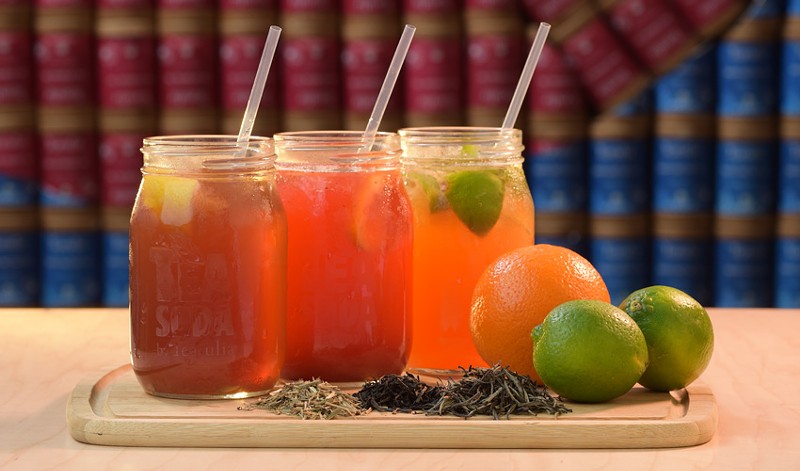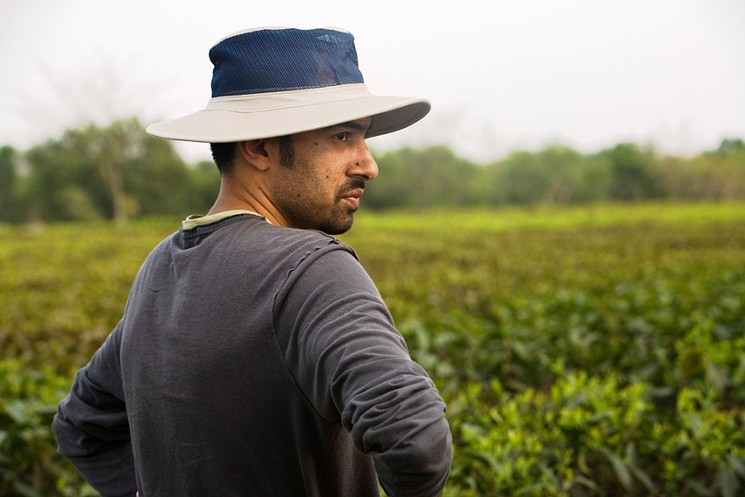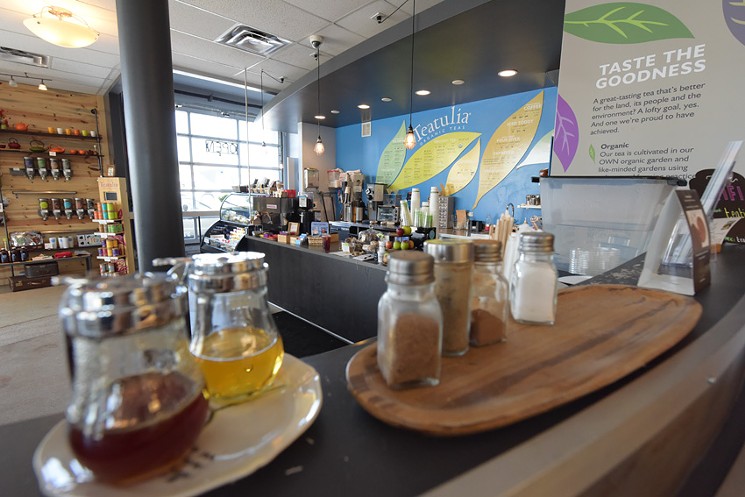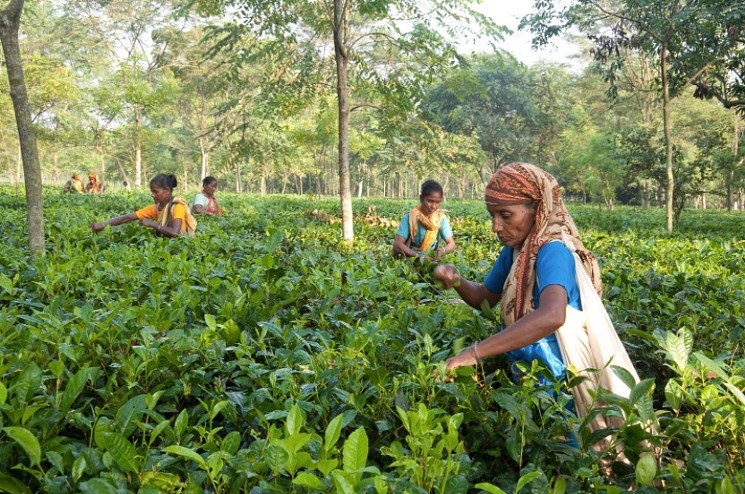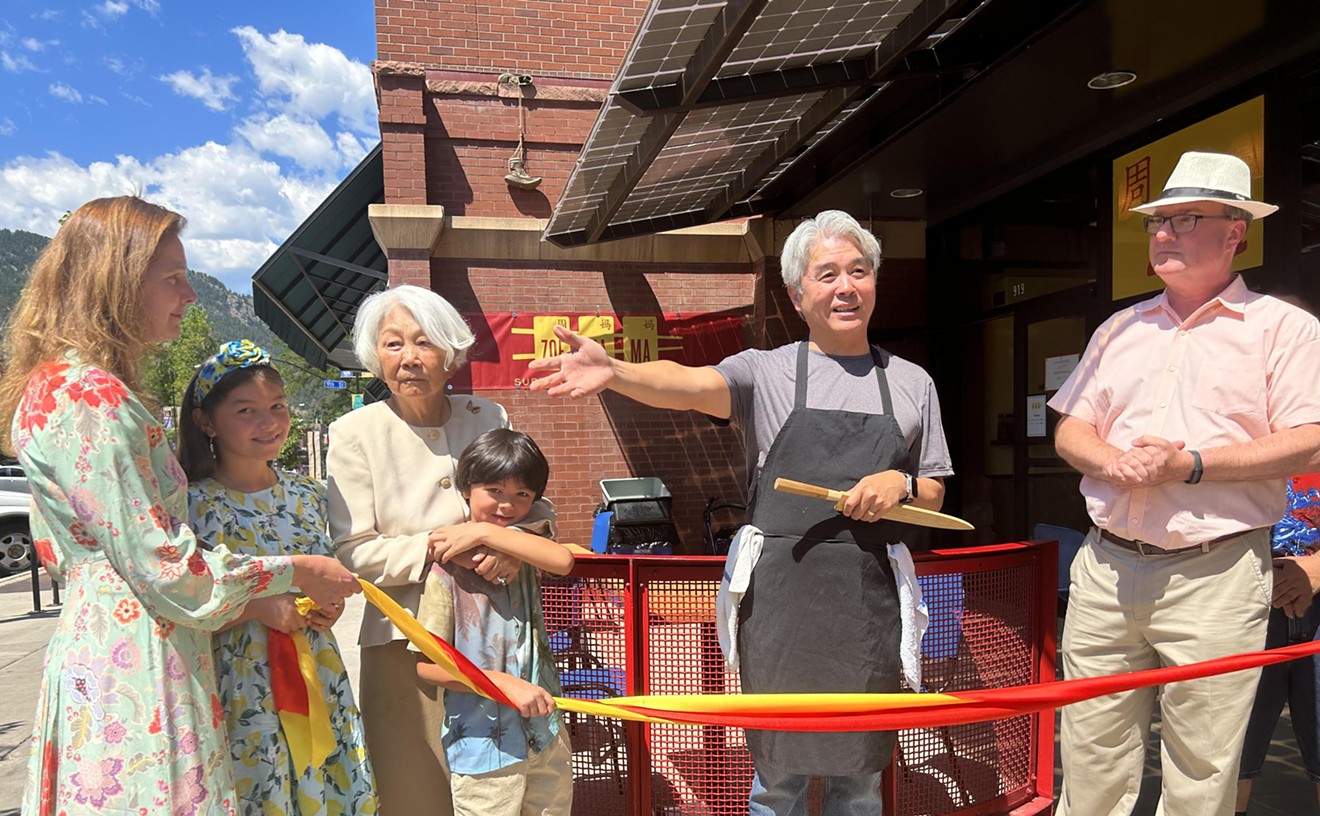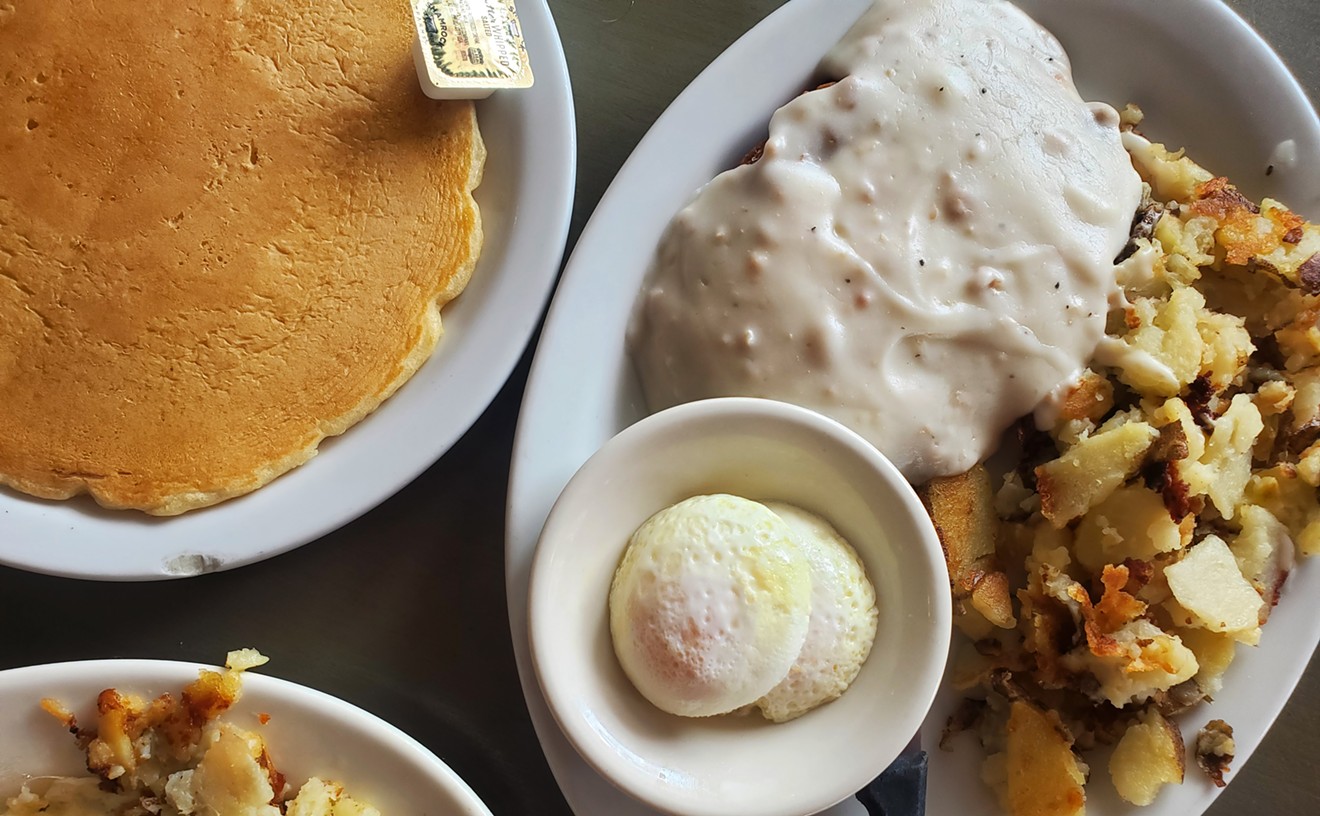Lipsius is the co-founder and CEO of Teatulia, an organic garden-to-cup tea brand, and we’re standing in her cafe in LoHi, sampling a significant portion of Teatulia’s line. Something about the way Lipsius is looking at me, a searching look that’s free of judgment, compels me to be honest. I am not a tea drinker, I confess; I’m spiritually a coffee drinker, and the only time I venture into the tea world is when I’m trying to lower my caffeine intake — and then I drink steeped herbal beverages, technically not tea, since they don’t come from the camellia sinensis plant.
She nods and tells me that she understands. “I drink a French press of coffee every morning. How about iced tea?”
Oh, sure, every time I eat in a fast-casual restaurant or don’t want to booze with lunch. I also drink green tea at sushi restaurants and black tea at dim sum parlors. Traveling to tea regions and insisting on coffee seems ridiculous, so I faithfully drink mate in Argentina, Earl Grey in the U.K., pu’er in China.
“So you do drink tea,” she says with a sly grin. “We have pins: tea geek and tea-curious. Would you say you’re tea-curious?”
I nod.
“And do you enjoy tea, or is it something you do for your health?” she asks.
“Both,” I say.
“And what kind of coffee do you like?”
I describe my perfect cup, fruity and light and delicately brewed. She files this away, and while she never overtly returns to my coffee habit, over the course of our conversation, she somehow makes me realize that not only is the coffee I drink awfully tea-like, but she convinces me that there’s no reason a spiritual coffee drinker can’t also be a tea drinker. I walk out with a tea soda, a tea book and a stash of leaves — and a few hours later, I find myself brewing a cup.
I realize that Lipsius was sizing me up so that she could make a more effective pitch. We might have been talking tea, but Lipsius is a skilled saleswoman, trained in her family’s legendary OrangeGlo and OxiClean business, and she never passes up an opportunity to gain a new customer. Convincing coffee drinkers like me to change their habits is integral to Teatulia’s success.
And Teatulia’s success does far more than line the CEO’s pockets. Lipsius and co-founder Dr. Kazi Anis Ahmed are using Teatulia to economically and ecologically revive a very poor region of Bangladesh, and they’re taking on the structure and practices of the entire tea industry in the process.

Linda Appel Lipsius co-founded Teatulia to help revive the economy in Bangladesh.
Courtesy of Linda Appel Lipsius
Shahid thought tea had potential, though it wasn’t an obvious choice. Although Bangladesh is one of the largest tea-producing regions in the world, Tetulia didn’t have a tea industry at all — which is even more remarkable considering that the region borders Darjeeling, India, which produces some of the most expensive and sought-after tea on the international market. Moreover, little of what tea is produced in Bangladesh is exported, which means that tea makes pennies of profit, not enough to sustain an economic revival. The economic challenges paled beside the environmental hurdles, however: Tetulia had suffered through years of agricultural neglect that left the land hostile to cultivation. Stone-gathering for a local concrete trade had depleted the soil of its nutrients and caused desertification of much of the area.
Even if Shahid could overcome the environmental challenges, doubters were sure that he would never be able to launch a tea plantation without bringing in experienced tea producers from other regions to sow the initial crops. “That would defeat the point,” says Anis, and not only because it would fill garden jobs with people from elsewhere instead of the neighbors the family was trying to help. It could also import some deeply troubling and long-ingrained labor practices from the global tea industry.
When the British planted tea in colonial India, thereby circumventing China’s long-held monopoly on the plant, it installed an employment model that is still common on modern plantations: Workers are essentially indentured servants, bound by contracts that keep them living and working on the garden for the duration of their lives.
They’re often paid in currency that only works on the plantation, and many suffer from substance-abuse problems. Bangladesh is a dry country, but alcohol is legal on the farms. Workers are encouraged to drink, fostering an unbreakable dependency. “There’s so much romance around tea, but it’s heartbreaking to think about the people who are producing it,” says Anis. “They endure horrific conditions for their entire lives.” The Ahmed family wanted to create real economic change, though, and was willing to weather short-term hits in order to educate their new workers and avoid the pitfalls of the commodity tea gardens. For starters, they implemented an employment system under which workers would make a fair wage and live with their families, as opposed to on a plantation.
Shahid ultimately purchased 3,000 acres for the garden, which “was bush and shrubs and a lot of sandy soil when we first moved in,” recalls Anis. His three sons began working with him, and they pushed to make many areas of the business sustainable. They started out by planting about half the land, choosing native and endangered trees for shade and making the garden a bit of a natural conservatory. It was also organic, “and not just the certification,” says Anis. He’d read about Japanese farmer Masanobu Fukuoka, who’d perfected and promoted low-intervention natural farming, which considers an area’s entire natural ecosystem. Plant crops that thrive together, the theory goes, and they’ll sustain themselves naturally, facilitating good land and soil management while rendering chemical pest control unnecessary. Fukuoka had spent his life using this type of farming to re-seed and revive desertified regions all over the world.
In addition to creating environmental benefits for the land and crops, farming like this means workers don’t spend their days working with chemicals. “You see sixteen-year-old boys in flip-flops and T-shirts applying the pesticides,” says Lipsius. “Women work in it all day.”
Organically produced tea is also a boon for drinkers. “Unlike with coffee, it’s the exposed leaves that are getting coated in pesticide,” adds Lipsius. “And the first time tea is washed is in your cup.”“There’s so much romance around tea, but it’s heartbreaking to think about the people who are producing it.”
tweet this
After a series of experimental harvests, the garden sprang to life and began producing organic teas that Anis thought could compete in a premium market. “We were making beautiful, rolled leafy teas” on par with what was coming out of Darjeeling or Sri Lanka [labeled by its historic name, Ceylon], he says.
By 2004, the garden had experienced some commercial success: Its tea, then labeled Kazi & Kazi Tea Estate LTD, became the first Bangladeshi tea to grace the shelves of Harrods, the upscale department store in London.
Anis thought the American market would be even more receptive; since the tea tradition wasn’t as entrenched in the U.S., drinkers were likely to be less discerning about the country of origin. But as he explored opportunities around the States, he became frustrated. “When we went to bulk buyers, they’d say, ‘Bangladesh is not a name for tea, so we’ll give you $1.50 or $2 per pound, at the most,’” he remembers. Anis and his brothers realized that the country of origin was never going to make their tea an enticing prospect; those bulk buyers would just package the tea as a commodity, ensuring that consumers would never hear the garden’s story, or pay more for the product.
As Anis began pondering how to get the story out to American consumers, he found himself sitting in a kitchen with Linda Lipsius. “I asked, ‘Do you know someone who could help us?’” he recalls. “She said, ‘How about me?’”
It turns out that I’m not the only one who’s been seduced by Lipsius’s unique ability to persuade people to drink more tea. Her husband, Adam, marvels at Lipsius’s sales prowess, too. “She’s an irresistible force,” he says. “She is the master of the sales call. She can do no wrong when she goes in to pitch. People always relate to her, and they find themselves trying to make it work out for her.”
“Linda is a star,” says her father, Max Appel. “She’s a natural. She’s not afraid to try new things. She has a great facility for working with people. She’s empathetic. She listens.”
If she’s a natural, it’s in her genes. Lipsius grew up watching sales in action: Appel sold environmentally friendly garbage sweepers until he invented OrangeGlo, an orange-tinged, environmentally friendly furniture polish that Lipsius remembers him first cooking up in the garage. “Then one of the neighbors complained because we had all these trucks coming in,” Appel recalls. “The cops said, ‘Well, he’s gotta make a living somehow, so leave him alone.’”
Appel used to take his entire family to work the OrangeGlo booth at home shows and state fairs, where the product was originally marketed; Adam Lipsius speculates that this was the basis of his wife’s abilities. “She got that invaluable experience that comes from needing to put up or shut up,” he says. “You’re standing in the hot sun at a table next to your dad, and needing to move product. I think it’s those humble beginnings: overcoming challenges, obstacles, adversity, and having the determination to not think you’re behind the eight ball. They just went and did it. No one told them they couldn’t — or if they did, they weren’t listening.”
Those first home shows proved to be excellent focus groups, Appel remembers, because he got instant feedback from every customer who saw him demonstrate his product. He worked OrangeGlo into retail sales from there. Then one of his chemists created OxiClean, which further opened up the market. “One of our chemists had seen a product that was natural, but it was being used commercially,” Appel remembers. “It was about taking it from that market and putting it into a consumer market.”
While at a home show, Appel met pitchman Billy Mays when the two were hawking products from adjacent booths. After forging a friendship, Appel hired the high-energy (and now deceased) Mays to pitch OxiClean on infomercials in which he demonstrated the product’s effects on laundry stains and spills in thirty-minute and two-minute spots. It was then that sales really took off. “Instead of talking to five people at a time, you’re talking to five million people at a time,” recalls Lipsius. Walmart picked up the products, and OrangeGlo and OxiClean were soon on retail shelves all over the country.
Even so, Lipsius kept manning sales booths during a college summer internship with the family company. Upon graduation, she officially joined her brothers and parents in the business, heading to London to set up the European operation after Walmart made OxiClean a focal point of its expansion on that continent. Her experience pitching cleaning products taught her three particularly valuable lessons for building a commodity business.
The first was about positioning: “If you can claim higher-level attributes, you enter different territory than straight commodity,” she says. The environmentally friendly bent of OrangeGlo and OxiClean helped the company carve a niche in the cleaning-product market — and the volume play of infomercials built on that toehold.
The second lesson was about demos. “You’re doing face-to-face market research,” says Lipsius. “It’s invaluable. You’re getting immediate feedback and seeing if your positioning makes any sense.”
And the third? The value of storytelling. “Cleaning products are commodities,” she says. “You’re creating a brand with a story.”
In 2006, the Appel family sold OrangeGlo and OxiClean for $325 million, leaving all the family members to go their own way, armed with cash and the valuable lessons they’d learned. And soon after, when Lipsius was ready to apply all of her experience in a new area, she found herself in that kitchen talking to Anis about tea.“She’s an irresistible force. She is the master of the sales call. She can do no wrong when she goes in to pitch.”
tweet this
Lipsius wasn’t particularly interested in tea in those days, but she’d been friends with Anis for several years. The pair had met through her husband, a film director who’d sat next to Anis for countless mornings in a Manhattan coffee shop. “I was writing the great American novel, and he was penning the great Bangladeshi novel. And you’ll have to take our words for it, because neither was ever published,” says Adam. But they never spoke until the morning that Monica Lewinsky walked through the door.
“This was in the ’90s, so there was no way we could not talk about her being there,” recalls Adam. He and Anis soon became fast friends, and after Adam later met Lipsius on a subway platform, she, too, became part of their social circle. In the early 2000s, Adam and Linda even traveled to Bangladesh for Anis’s wedding, passing up the chance to see the tea garden in its early days because the trip required a two-day trek up barely passable roads. (Each has since made the journey.)
Now, as she and Anis talked tea in the kitchen, Lipsius quickly realized what he had already begun to suspect — that it made no sense to sell the garden’s tea in bulk to other brands. “Most of what’s on the market is dirty,” explains Lipsius. “It’s leaching the ground, or not adding environmentally, and it’s of low quality. This was steps ahead.” It was also an unusually positioned product with a great story, she realized: If they could get consumers to care about the garden’s social benefit and environmental orientation, they’d be able to sell more tea, which would only enhance Shahid’s original mission to economically revitalize Tetulia.
The pair laid out a vision for a fully integrated garden-to-cup company, controlling the tea from planting and picking through packaging with compostable and biodegradable materials to sales. With this system, they’d be able to control quality, and they’d also be able to guarantee an environmentally and socially sustainable product, a difficult proposition in an industry filled with middlemen.
And with that, Teatulia’s business plan was in the bag.
The early days of Teatulia were not unlike the early days of OrangeGlo. “The first thing we did was a booth at the Cherry Creek Farmers’ Market,” remembers Lipsius, and through the direct feedback she got from visitors, she realized that her biggest challenge in bringing tea to the American market was going to be education.
“People don’t necessarily know the continuum of good tea,” she explains. “They’re more intimidated than they are by wine. With wine, you have words — with tea, people don’t know what to ask for.”
Moreover, American consumers often haven’t been exposed to good tea, and have been turned off by the bad stuff. “With tea, it really matters where it comes from,” Lipsius notes. “Often, people have not crossed over because what they’ve had is bitter. They drink it because they think they should, not because they want to.”
Statistics back this up: The hot tea category has grown 15 percent over the past five years, according to the Tea Association of the U.S.A, because health-oriented consumers are after its nutritive properties. This also explains why functional lines such as Yogi Tea and Traditional Medicinals have garnered a lot of market share in recent years. These companies market their teas as helping specific ailments: Traditional Medicinals’ Smooth Move goes after constipation; Yogi Tea blends offer stress relief, skin detoxification and probiotic balance.
Lipsius found that she could often quickly counteract a potential Teatulia customer’s aversion to tea just by offering a taste. “Our flavor profile is unique,” she says. “It’s full-bodied but very sweet, with a smooth finish. People always think we’ve added sugar just because it has natural sweetness.” But a full education took more time than she had in a farmers’ market conversation.
All tea comes from the camellia sinensis plant, she explains, which is maintained at about waist height and can live for hundreds of years. Producers harvest the leaves and the bud; the difference between white, green, oolong and black tea, then, lies in how it’s processed.
Black tea is fully oxidized, a process initiated by rolling tea leaves to macerate them. This releases heady malty, fruity, earthy and sometimes smoky aromas and flavor compounds. Oxidation is halted with heat, and before oxidation goes too far: Too much oxidation can impart odd fermented or medicinal notes. Green tea, by contrast, isn’t oxidized at all — it’s heated via pan firing or steaming as soon as it’s plucked — so it retains its vegetal and grassy qualities. Depending on the heat method, it might also carry a toasty flavor. Oolong tea is partially oxidized, which puts it between black and green from a flavor standpoint; how much oxidation a producer allows will determine whether it skews toward either end of that spectrum. Oolong is also differentiated by its shape — the leaves are rolled into tight balls or strands. Finally, there’s white tea, which uses just the buds, dried “like a raw food,” says Lipsius, which gives it a much more delicate flavor than its counterparts.
Black tea is the favored variety in America, in large part because of sweet tea drinkers in the South. But Lipsius recommends that tea newcomers start with white tea, if only because it’s so easy to drink. It also happens to have the highest anti-oxidant count and lowest level of caffeine. (Black tea has the inverse — fewer anti-oxidants and more caffeine.) Teatulia’s white tea is particularly good: It has a bit of a floral note, with a little stone fruit and honey, and none of the bitterness you find with other varieties. It’s also Lipsius’s favorite.
As for herbal teas, they’re not actually tea at all, she says: “The technical term for anything that doesn’t have the plant is tisane, or herbal infusion.” Teatulia’s line includes a few of these, like lemongrass, which is also culled from the garden in Bangladesh, and chamomile, which the company sources from a garden in Egypt vetted to meet its standards.“With Teatulia, you get something really special. They actually own the farm where the tea comes from.”
tweet this
Even if you find a tea you like, she says, you can ruin it with over-steeping, another intimidating and off-putting factor for non-tea drinkers. “Herbals are totally forgiving,” Lipsius notes. But leave a black tea longer than five minutes, and a green or white tea longer than about three minutes, and you can ruin them: They start to take on the tannic and astringent qualities that turn a lot of people off tea forever. Steep time is more important to consider than water heat; Lipsius says that black tea can take boiling water, while green and white do better with slightly cooler water. “Take it off the boil and wait a minute,” she advises.
Over the years, Teatulia has graduated from farmers’ markets to retail and restaurants. Today you can find the teas in places as diverse as Whole Foods Market, fast-casual chains like Garbanzo and Tokyo Joe’s, finer-dining establishments such as Root Down and Frank Bonanno’s restaurants, and in several university cafeterias. Lipsius spends much of her time educating buyers for all of these outlets, in hopes that some of her tea knowledge will be passed on to consumers. You can also get a quick course in Tea 101 at the Teatulia Tea Bar, the company’s retail outlet, at 2900 Zuni Street. In addition to providing an opportunity to taste through the Teatulia lineup, the cafe just launched a monthly class series aimed at getting drinkers in for a taste.
Lipsius realizes that not everyone is willing to pay — or sit through — a tea class. Early on, she recognized that if she wanted to vastly expand Teatulia’s footprint and turn people on to the complexity you can find in tea, she’d need a more subtle way to reach the American consumer.
According to the Tea Association of the U.S.A., America is the third-largest importer of tea in the world, and Americans consumed more than 84 billion individual servings of the stuff in 2016. Four out of five adults are tea drinkers, and that number is increasing, with 87 percent of millennials reportedly drinking tea. But if you ask many of these people whether they drink tea, they’ll tell you no. Why?
The answer, of course, is iced tea. “I always think it’s funny when I ask someone if they drink tea, and they say no, and then I ask them if they drink iced tea, and they say yes,” Lipsius says.
Nearly 80 percent of all tea consumed in America is iced, and much of that is being sipped in restaurants, occasionally dispensed from soda fountains and often made from bag-in-box tea syrup as opposed to freshly brewed leaves. “Food-service iced tea has really been the bottom of the barrel,” says Lipsius. “A lot aren’t fresh-brewed; companies are using concentrate that doesn’t resemble tea. You really start to taste the chemicals.” Ramp up quality in that arena, she thought, and you’d not just sell more tea, you’d also open the palates and minds of the drinkers you’re serving.
The vast opportunity in the food-service iced tea market was enough to make Teatulia pivot from focusing on its packaged line to concentrating on what it could offer in restaurants. “It’s a whole new world,” says Lipsius. “It allows us to have high volume and margin and impact beyond foodie tree-huggers into fast-casual.” Four years ago, the company unveiled a line of freshly brewed iced teas that range from basic black to sweet to custom herbal blends.
The offering was a boon to Tokyo Joe’s, which started offering iced tea blends from Teatulia two and a half years ago. “We’ve always had a large tea program,” says Seth Pickett, Tokyo Joe’s director of purchasing. “It’s something we really love and is a big part of us. Our next step was going fully organic. There are a number of good people within Denver who do great teas, and there are other companies that do only organic teas. But with Teatulia, you get something really special. They actually own the farm where the tea comes from. They care a lot about the quality of the tea and what goes into it. They’re the only one I know that’s truly managing it farm-to-table, and not in a buzzword way. That spoke exactly to what we wanted.”
Pickett decided to bring in six iced teas — black, sweet, a custom-made sugar-free sweet made with stevia, raspberry hibiscus, pomegranate green and passionfruit black. As a result, Teatulia, the only co-branded product in the Tokyo Joe’s restaurants, takes up about twenty feet of counter space. But it’s worth it, says Pickett, because the locations do a brisk business in iced tea. “We go through a lot of the iced teas,” he notes. “We’re a healthier concept, so we sell fewer drinks than you would imagine — people choose water. But teas also fit that mold. If you’re doing an unsweetened or stevia-sweetened tea, it’s just as hydrating as water. It’s easier to switch from soda to iced tea. I think that’s why iced tea keeps gaining footing. That and Diet Dr Pepper are the only beverages people write us to say, ‘Hey, I love that you have this.’”
The most popular flavor? “Raspberry-hibiscus,” says Pickett. “It’s a big hit with kids.”
In addition to Tokyo Joe’s, Teatulia has co-branded setups with Garbanzo, Illegal Pete’s and Park Burger, all homegrown chains. The iced black tea is an easy sell, Lipsius says, because it’s naturally sweet and creamy. The company has also pushed out that stevia-sweetened sweet tea to other concepts, building on its popularity at Tokyo Joe’s. And the popularity of iced tea with customers also led to an unusual offering at the Teatulia Tea Bar: tea sodas, which Lipsius calls “gateway drugs” to the world of tea. Flavor combinations includes matcha with mint and lemonade, and white tea with pineapple, lime and cucumber.
Iced tea is a good way to turn people on to tea flavors without asking them to go full-bore, says Lipsius: “After that, you start asking them to stop putting things like sugar in tea, and you go from there.”
While Teatulia is just getting started in the American market, it’s already had a tangible effect in Bangladesh. Today, the tea garden employs about 800 people full-time, and those ranks swell to 1,000 during harvest.
It’s also empowered a dairy cooperative that’s had a much broader impact on the region. In order to abide by organic standards, Teatulia’s garden needs a massive quantity of organic cow dung. “We realized if we were to keep the cows for that dung, we’d need more space than we need for the garden,” explains Anis. So the company innovated, giving a cow to anyone in the community who wanted one — and about 3,000 people accepted the offer. The owners pay back Teatulia via a weekly fixed supply of dung and milk, and they’re free to sell any surplus on the market and use their cow however else they see fit, as long as they can adhere to the company’s organic requirement. And offspring are not considered part of the loan: “If the cows calve, they get to keep the calves,” says Anis. “I wish cars were like that.” Full repayment usually takes about two years, he adds.
Predictably, Teatulia’s success has inspired other tea gardens to set up shop in the region. It’s also had a wide influence on local farming practices, even if just on tiny plots being cultivated for private use. As a result, says Anis, “ecological restoration has been beyond our original conception. We’ve been able to return that little patch of Bangladesh, which had no farming and was very arid, to its original state of ecosystem. Old farmers there say, ‘I remember we used to see foxes when we were children.’ They hadn’t seen them for decades, and now they’re back.”
As the company grows, the garden will also expand. The Ahmed family will eventually plant the remaining acres on their plot, and they hope to grow the dairy cooperative to help farmers secure better prices and give consumers a more direct line to their goods. But they also want to push the Teatulia agricultural model for other products and in other regions. “We hope to take all the social things we do and make that transferable to other areas, and reach many more than the 3,000 or 4,000 people here,” says Anis. “The single original garden is not infinitely scalable, but the ideas taken to other areas become something accessible to many others.”
Here in the States, Lipsius predicts slow but sure growth. “I think in the next ten years, we’re going to see a real uptick,” she says. “My daughter is ten, and half of her friends come to school with a tumbler of tea. Kids can’t order coffee, so they’re getting tea.”
Functional teas will continue to grow, as will organic, even as commodity brews (like Lipton and Boulder-based Celestial Seasonings) start to shrink, she predicts. And eventually, maybe this country will get to the point where tea salons like Teavana, the Starbucks experiment with steeped beverages, will be as prevalent as coffeehouses. “It’s growing, but I don’t think we’re there yet,” Lipsius says. “We serve coffee at the tea bar, because we’re still a coffee-drinking country.”
In the weeks after I meet with Lipsius, I don’t replace my coffee with tea. I don’t even cut down my coffee intake. But I do amp up my tea consumption considerably, since I no longer feel like I have to choose between being a coffee or a tea person.
Turns out I can be both.

